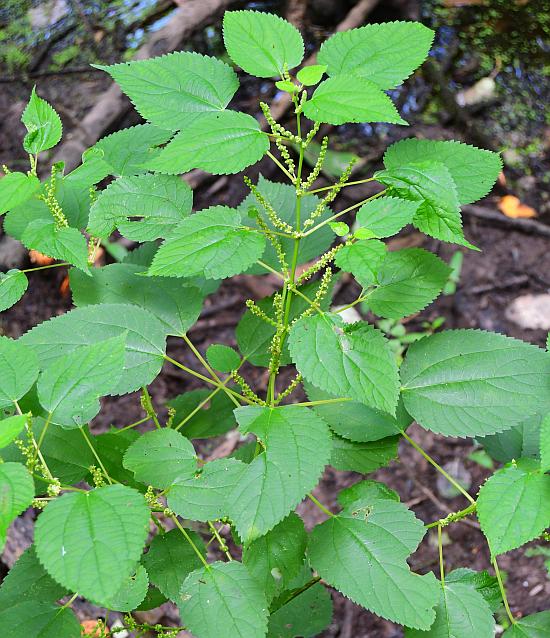Boehmeria cylindrica (L.) Sw.
False Nettle

Native
CC = 4
CW = -5
MOC = 77
© SRTurner
Boehmeria cylindrica (L.) Sw.False Nettle | |
 |
Native CC = 4 CW = -5 MOC = 77 |
© SRTurner |
|
Family - Urticaceae Habit - Perennial forb with rhizomes and fibrous roots, unarmed, monoecious or dioecious. Stems - Ascending to erect, to 1.5 m, glabrous or pubescent, stinging hairs absent.
Leaves - Opposite, simple, mostly long-petiolate. Blades 3-15 cm long, the pair at a node often unequal in size, lanceolate to elliptic, broadly elliptic, ovate, or broadly ovate, somewhat asymmetrically angled to rounded at the base, tapered at the tip, the margins regularly toothed, the venation with the 2 basalmost lateral veins more developed than the others, usually glabrous.
Inflorescence - Small, dense, axillary clusters arranged into short or elongate and interrupted spikes, these sometimes leafy toward the tips, the staminate flowers scattered among the pistillate flowers or in separate spikes (rarely the plants totally dioecious). Bractlets not forming an involucre.
Flowers - Staminate flowers with 4 sepals, these 0.7-1.1 mm long, cupped around the stamens. Stamens 4. Pistillate flowers with 4 sepals fused nearly to the minutely 2- or 4-toothed tip (the calyx appearing more or less flask-shaped, but flattened), 0.6-1.0 mm long, enclosing and fused to the ovary and fruit. Style elongate (exserted from the calyx), the stigmatic region linear.
Fruits - Achenes 0.6-0.8 mm long, remaining enclosed in the persistent calyx, which appears flattened, with a pair of thick wings, the surface with sparse to dense, ascending, sometimes hooked hairs. Flowering - June - October. Habitat - Bottomland forests, streambanks, fens, moist and shaded areas. Origin - Native to the U.S. Lookalikes - Other members of the Urticaceae (nettle family), especially Urtica dioica and Laportea canadensis. Other info. - This nettle-like plant is found throughout most of Missouri, with the exception of the northwestern corner. It is common throughout the eastern half of the continental U.S. and ranges into Canada as well. It is almost always found in shaded bottomland forests, where it is common. When not in flower it can be difficult to distinguish from stinging nettle (Urtica dioica). A key difference is Boehmeria's lack of stinging hairs, but this can be a painful character to evaluate if the specimen under examination turns out to be Urtica! Furthermore, some specimens of Urtica can be nearly glabrous. Determination of flowering specimens is easier, since the inflorescences are compact and cylindric rather than branched into multiple slender, spikelike racemes. Photographs taken in bottomland along the Missouri River in Washington, Franklin County, MO, 8-25-2016, and at Otter Slough Conservation Area, Stoddard County, MO, 8-16-2021 (SRTurner). |